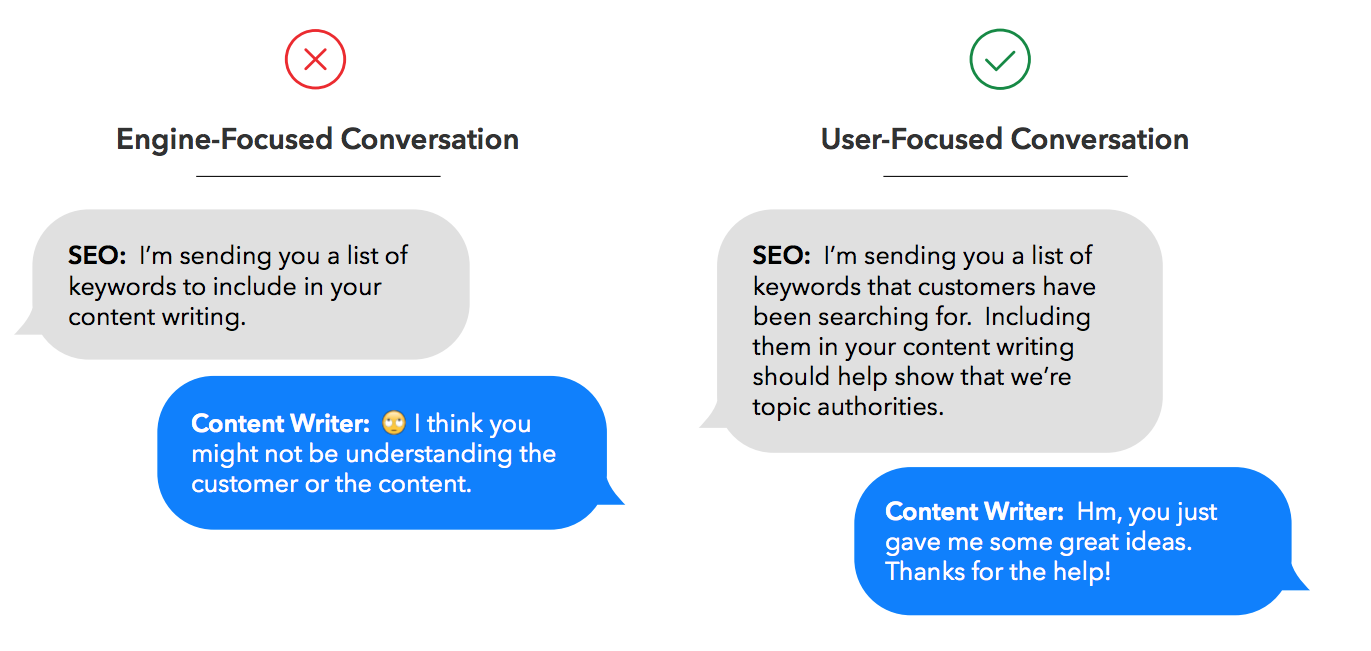Can you imagine a modern marketing strategy without content and SEO?
Quality content is crucial for high organic rankings, while SEO data enhances content strategies to attract the right audience. Despite their complementary goals, content marketing and SEO teams often work in silos, reporting to different managers or having competing priorities, which hampers productivity.
The result? Missed opportunities for driving revenue and growth.
In this post, I'll share ideas on how SEO and content teams can collaborate effectively, leveraging their unique strengths. Let’s start with the basics.
Table of Contents:
- What Is SEO?
- What Is Content Marketing?
- Key Differences Between SEO and Content Marketing
- How Content Marketing and SEO Benefit Eachother
- How to Combine SEO and Content Marketing Together
What is SEO?
SEO, or Search Engine Optimization, is all about making your website more visible and attractive to search engines like Google. It involves optimizing content, improving technical aspects, and enhancing user experience to boost your rankings on search engine results pages (SERPs).
The goal is to drive more organic traffic by aligning with what both search engines and users are looking for. This includes strategies like keyword research, on-page optimization, link building, and more.
What is Content Marketing?
Content marketing is the strategic approach of creating and sharing valuable, relevant, and consistent content to attract and engage a target audience.
The goal is to build trust and authority, ultimately driving profitable customer actions such as conversions and brand loyalty. This can include blog posts, videos, social media updates, eBooks, and more.
By focusing on the needs and interests of your audience, content marketing helps establish a strong connection with potential and existing customers.
Key Differences Between SEO and Content Marketing
One of the primary differences between SEO and content marketing is how they view content.
Traditionally, SEOs see content as a tool for targeting relevant keywords, while writers focus on engagement, creativity, and buzzworthy content strategies.
This distinction and their different approaches are illustrated in our Building an SEO Center of Excellence eBook.
The visual below demonstrates how a simple shift in conversation can align the two teams perfectly.

Let’s also consider each team’s core interests and objectives.
Content marketers prioritize increasing engagement, audience building, and strengthening topical authority. They know what captivates the target audience and what information converts them into leads. Using this information, they create content assets to position the brand along the buyer’s journey for the most relevant topics.
SEOs, on the other hand, focus on data and metrics. They analyze opportunities using information from user behavior through Google and other data sources. SEOs also focus on dominating the SERPs for specific topics. They publish pages and content to secure good rankings for search queries that buyers would search for at different stages of their journey.
How Content Marketing and SEO Benefit Eachother
In truth, both SEOs and content marketers have the same objective: to position the brand along the buyer’s journey.
They do so with similar assets: content.
Content is inherent to any SEO strategy. In fact, no marketing campaign aiming to improve search visibility would ever be complete without it.
There would be no way to optimize a page for target keywords, provide a good user experience, or effectively build links to pages without engaging content.
On the flip side, it’s impossible to create meaningful and relevant content without data on customer search preferences and other key user insights that SEO teams provide.
Recommended Reading: 9 Ways SEOs Bring Value to Every Team in Their Organization
By validating and strengthening content marketers’ insights with data, SEOs help tailor the marketing strategy to reach the largest possible audience.
How to Combine SEO and Content Marketing Together
Below, I’ve listed several strategies to ensure the two teams start achieving their shared goals together.
Strategy #1. Create a Unified Content Roadmap
In most organizations, both content and SEO teams have strategy documents that define each team’s objectives and provide a roadmap to achieve them.
To begin strengthening the relationship between SEO and content marketing, compare each team's strategy documents to identify:
1.) Common topics and audience interests you target.
Look for overlapping themes and interests that both teams are targeting. This helps ensure that efforts are aligned and resources are used efficiently. When both teams focus on the same topics and audience segments, they can create content that is both engaging and optimized for search engines. This synergy maximizes the impact of each piece of content, driving more organic traffic and increasing engagement rates.
2.) Topic gaps.
These include ideas one team wants to target but the other doesn’t know about.
Filling these gaps can lead to new opportunities for content creation and optimization. By sharing insights and uncovering these gaps, teams can develop a more comprehensive content strategy that addresses all relevant topics and keywords. This not only enhances the breadth and depth of your content but also ensures that no valuable content opportunities are missed.
Strategy #2. Audit Content for SEO and Engagement
Existing content offers many opportunities for both teams to collaborate.
One key method is performing content audits to compare SEO and engagement data, helping both teams evaluate underperforming pages and identify ways to improve them.
For example, the SEO team can identify new keywords for the page to target that match the audience’s demand. To streamline this process, they can use the Content Ideas capability in seoClarity to uncover common questions the audience asks about a particular topic online.
(Content Ideas report showing top ranking content for a keyword.)
Another way to identify opportunities to improve existing content is by conducting a content gap analysis to compare what keywords competitors rank for and you don't. In doing so, you can uncover new phrases to target.
(Content gaps report showing the opportunity in keywords and traffic.)
Content writers or SEO content strategists can then use these SEO insights to enhance the existing content by adding new topics and semantic keywords, boosting relevance and aligning it with top-ranking content. This ensures the content is engaging and meets user needs.
Strategy #3. Identify User Needs Using SEO and Content Data
To engage today’s audiences, you need to understand their problems and deliver information that helps them solve those issues. SEOs and content teams approach this challenge differently but can achieve incredible results when they combine their efforts.
SEO Approach: SEOs analyze keyword data to uncover trends and topics their target audience is researching.
Content Marketing Approach: Content marketers focus on social media engagement, audience stickiness, and highly trafficked blogs to identify what resonates with readers.
Imagine the impact of combining these approaches!
Here’s how it works:
- Identify Audience Challenges: Writers identify new audience challenges through engagement metrics and feedback.
- Keyword Research: Communicate these findings to the SEO team, who will then research relevant keywords that match those problems.
- Collaborative Topic Refinement: Both teams work together to fine-tune the topic, ensuring it aligns with search intent and comprehensively covers the issue.
- Competitive Analysis: Evaluate how to outdo current ranking pages by combining content creativity with SEO insights.
Strategy #4. Evaluate the Competition Together
Analyzing top-ranking content is one of the fastest ways to discover new opportunities to rank higher. Both SEO and content teams should collaborate to uncover these insights.
SEO Team’s Role:
- Identify the factors that make competing pages rank well, such as content length, structure, type of information included, and other crucial elements of top-ranking content.
Content Team’s Role:
- Leverage social media data to see how well competing pages engage their audience. Use these insights to create content that not only ranks but also engages the audience even better.
By evaluating the competition together, SEO and content teams can develop a comprehensive strategy to create content that outperforms competitors in both ranking and engagement.
Conclusion
SEO and content are critical for any marketing strategy today. Unfortunately, the teams responsible for them often choose to work independently.
Hopefully, in this brief guide, you’ve discovered how to change that and combine each team’s expertise to drive even higher marketing ROI.
What are some ways that your content teams and SEO teams work together? Leave us a note in the comment section below!
<< Editor's Note: This post was originally published in November 2018 and has since been updated. >>







Comments
Currently, there are no comments. Be the first to post one!